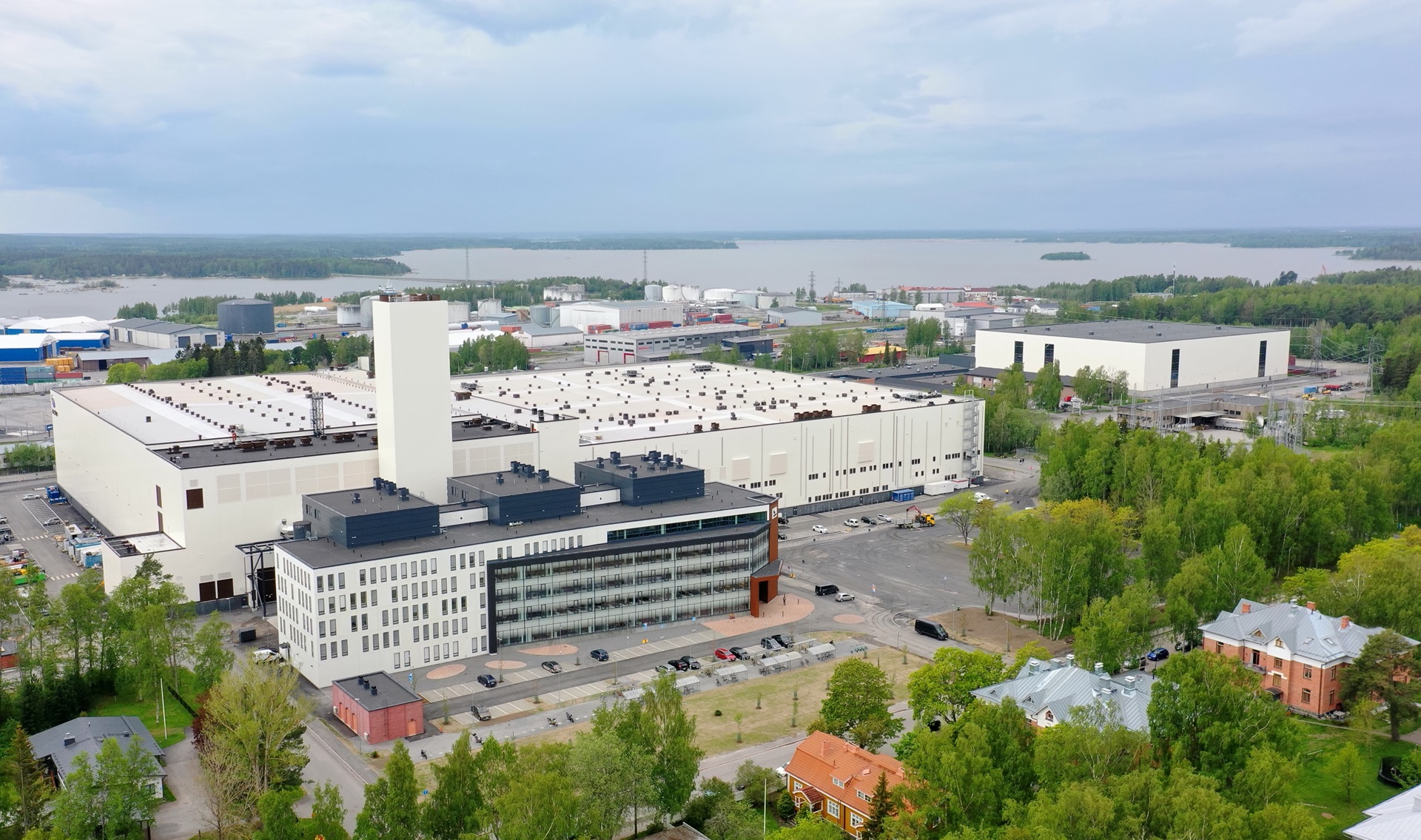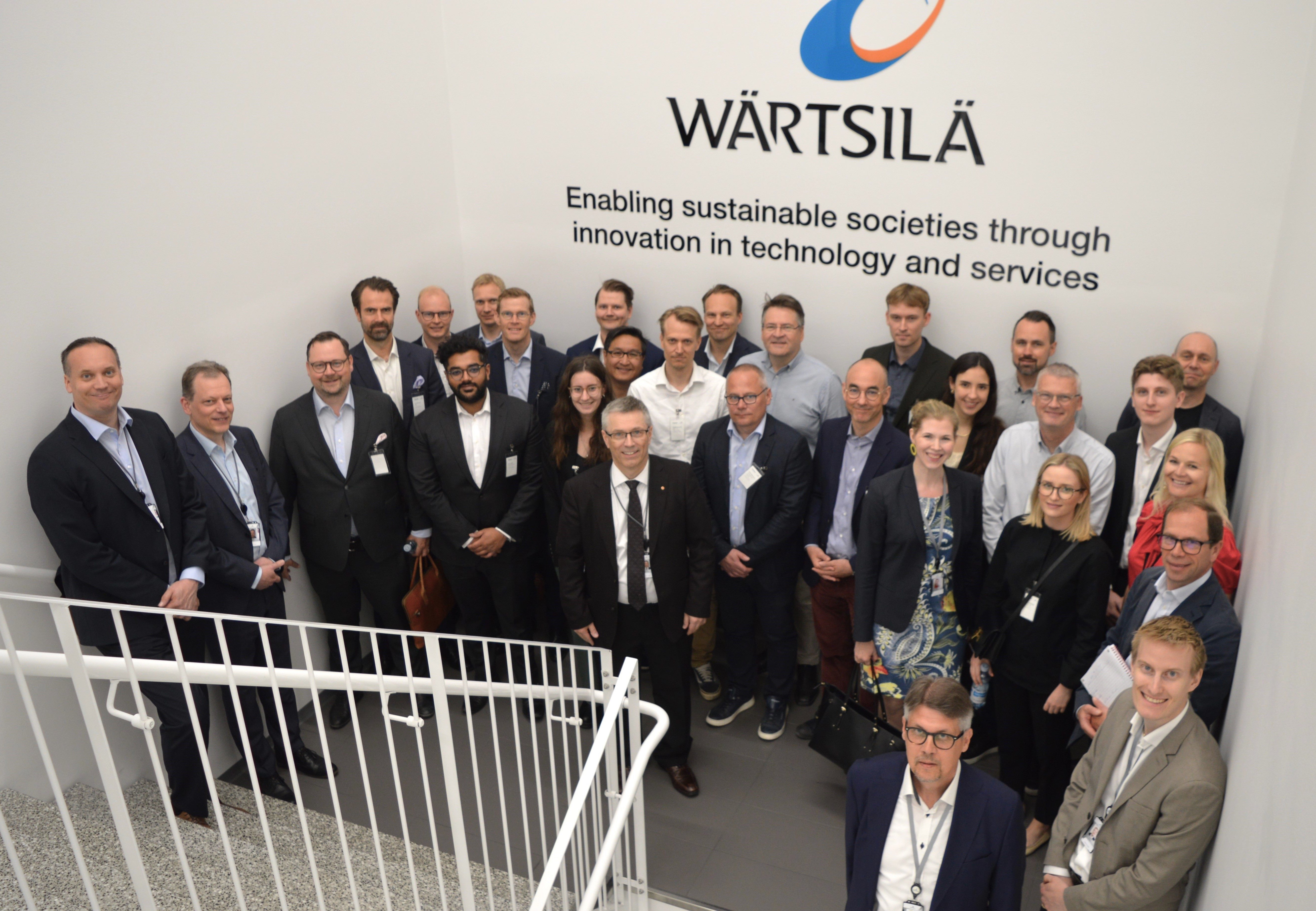

Wärtsilä Investor Relations organized a site visit to the Sustainable Technology Hub (STH) in Vaasa, Finland on 30 May. The event, aimed at investors and analysts, served as a continuation of a Marine theme call held earlier in May. The summary blog post of the Marine theme call can be read here.
The site visit event focused on decarbonisation, future fuels, and the role of internal combustion engines in future solutions. The presentation material from the event can be found here.

The Sustainable Technology Hub
Located in the heart of Vaasa, the STH is a testament to sustainable technology. STH was opened in 2022 and with an overall investment of 250 MEUR, the hub is dedicated to future technologies and sustainable manufacturing for both Marine and Energy industries. The hub is equipped with automated logistics, flexible manufacturing systems, and robotics. STH is pioneering the adoption of sustainable fuels, with engines designed and manufactured there already capable of operating on carbon-neutral and carbon-free fuels.
STH is targeting to be energy self-sufficient both for electricity and heat. Engine testing in STH produces more electricity than used in its operations. Excess power is fed back to the grid, and the heat created during engine tests or other processes is collected into a thermal energy storage tank and reused in-house.
Research and Development supporting decarbonisation targets
R&D at the new technology centre focuses on developing technologies such as engines, and digital solutions. A key focus area of R&D is the use of alternative fuels, as well as improving the connectivity, efficiency, sustainability, and safety of customer operations. The facilities in STH enable agile development and efficient research of sustainable solutions. STH employs professionals with different areas of expertise under the same roof, maximising the synergies in research, product development, new technology introduction, and manufacturing.
Wärtsilä has increased the R&D spending target, from an annual ~3% to an annual ~4% of net sales to support the decarbonisation targets further. Wärtsilä offers a future-proof and flexible product offering, which customers can rely on, especially given the tightening regulation environment.
Site Visit Highlights: internal combustion engines are a vital solution for maritime decarbonisation
During the site visit, attendees had the opportunity to visit the Fuel Laboratory where future fuels are researched and tested, the Expertise Centre where Wärtsilä engines are monitored in operation globally, and the Additive Manufacturing site producing components with 3D-printing technology. In the afternoon, Roger Holm, the President of Marine, and Mikael Wideskog, the Director of Sustainable Fuels and Decarbonisation, provided deeper insights into how internal combustion engines will power maritime decarbonisation and future fuels.
The Future of Sustainable Fuels
Roger Holm started the afternoon by explaining the changing regulatory environment, with fuel costs for vessels operating in EU waters potentially doubling by 2030 due to emission fees. He emphasized that the net-zero targets will require a fundamental shift towards sustainable fuels. Wärtsilä’s offering can support all the different decarbonisation pathways, making Wärtsilä customers’ preferred business partner in their decarbonisation journey. The different decarbonisation pathways can be roughly divided into three: burning less fuel by improving vessel and operational efficiency, cleaning up emissions, and using alternative energy sources. However, using alternative energy sources, either by sustainable fuels or electrification, is the only estimated pathway to reaching the 100% GHG emission reduction potential. Also, electrification in the maritime industry is only viable on short distances, due to the low energy density and large size requirements of batteries. For these reasons, internal combustion engines are a vital solution for maritime decarbonisation.
Wärtsilä is leading in fuel flexibility and fuel efficiency, with the industry’s most comprehensive offering for alternative fuel-capable engines. Wärtsilä’s engines have built-in upgradability to future fuels, with significant part commonality between different fuel versions and a modular design. Upgrading a multi-fuel engine to a new fuel requires a relatively limited investment thanks to high modularity and part commonality.
With the share of alternative fuel-capable engine orders steadily growing, standing at >60% MW from Wärtsilä’s orders in 2023, Wärtsilä’s engines are set to power maritime decarbonisation. Net zero targets will require a fundamental shift towards sustainable fuels, and Wärtsilä’s multi-fuel engines provide the most flexible pathway.
Wärtsilä focuses on developing future fuel solutions for methanol, ammonia, and hydrogen. Methanol has rapidly become the preferred choice for containerships and cargo, with the advantages of allowing simpler fuel handling than LNG, and low SOx (Sulphur Oxides) and PM (Particulate Matter) emissions. Methanol also has a high retrofit potential. Wärtsilä has contracted over 160 methanol-capable engines before May 2024. Another growing fuel is ammonia. Wärtsilä launched the world’s first 4-stroke ammonia solutions for marine in December 2023. Ammonia is a zero-carbon fuel, and very low in SOx and PM emissions, but it has lower energy density compared to LNG, which means that it requires bigger volumes to store the same amount of energy. Hydrogen’s transportation and storage challenges will limit the uptake in marine. Therefore, it is estimated to be used more in land-based engines. The 100% hydrogen technical concept is estimated to be ready by 2025 for Energy markets, and Wärtsilä’s LNG DF engines can already run on 15% hydrogen blends without modifications. Hydrogen is also a zero-carbon fuel and is very low in SOx and PM emissions.
Q&A
What is the current technical capacity utilisation of STH?
We are currently operating below the maximal technical capacity which is mainly determined by the testing capacity.
Where in Marine do you see the biggest potential to gain market share?
We are market leaders in 4-stroke medium-speed main engines, with particularly high market shares in high-value vessel segments such as Cruise, Ferries and Offshore. Decarbonisation is an important growth driver for us: our market share is even stronger on alternative fuel-capable engines, and we are also market leaders in hybrid solutions. We also see a lot of interest in the market for our new and upcoming products, including carbon capture and storage (CCS), as well as our Hybrid-Electric solution which challenges 2-stroke as a prime-mover for LNG carriers.
How does the move to alternative fuels impact your service business?
The move to alternative fuels supports growth in our service business, driven by for example higher uptake of agreements with alternative fuel-capable engines, and the emerging decarb-related retrofit market.
What’s the outlook for future-fuel pickup? Have shipowners been resistant to new investments?
The outlook for future-fuel pickup is positive as the pickup continues to increase across vessel segments. Containerships are one of the frontrunner segments in alternative fuel pickup with ~60% of containership tonnage on order book enabled either for methanol- or LNG-power.
Overall, in Q1/2024, 29% of ordered ships and 45% of the capacity were capable of running on alternative fuels, while ~50% of the shipping order book by compensated gross tonnage millions is set to run on alternative fuels. For Wärtsilä, the share of alternative fuel-capable engine orders is steadily growing, standing at >60% MW in 2023.
You mentioned that over 60% of MW ordered in 2023 are alternative fuel-capable engines. What is the split between different alternative fuels?
We haven’t given the exact split. It is good to note, that different fuels are in different phases regarding maturity. Regarding the whole industry, LNG and methanol are still the two most preferred alternative fuel options.